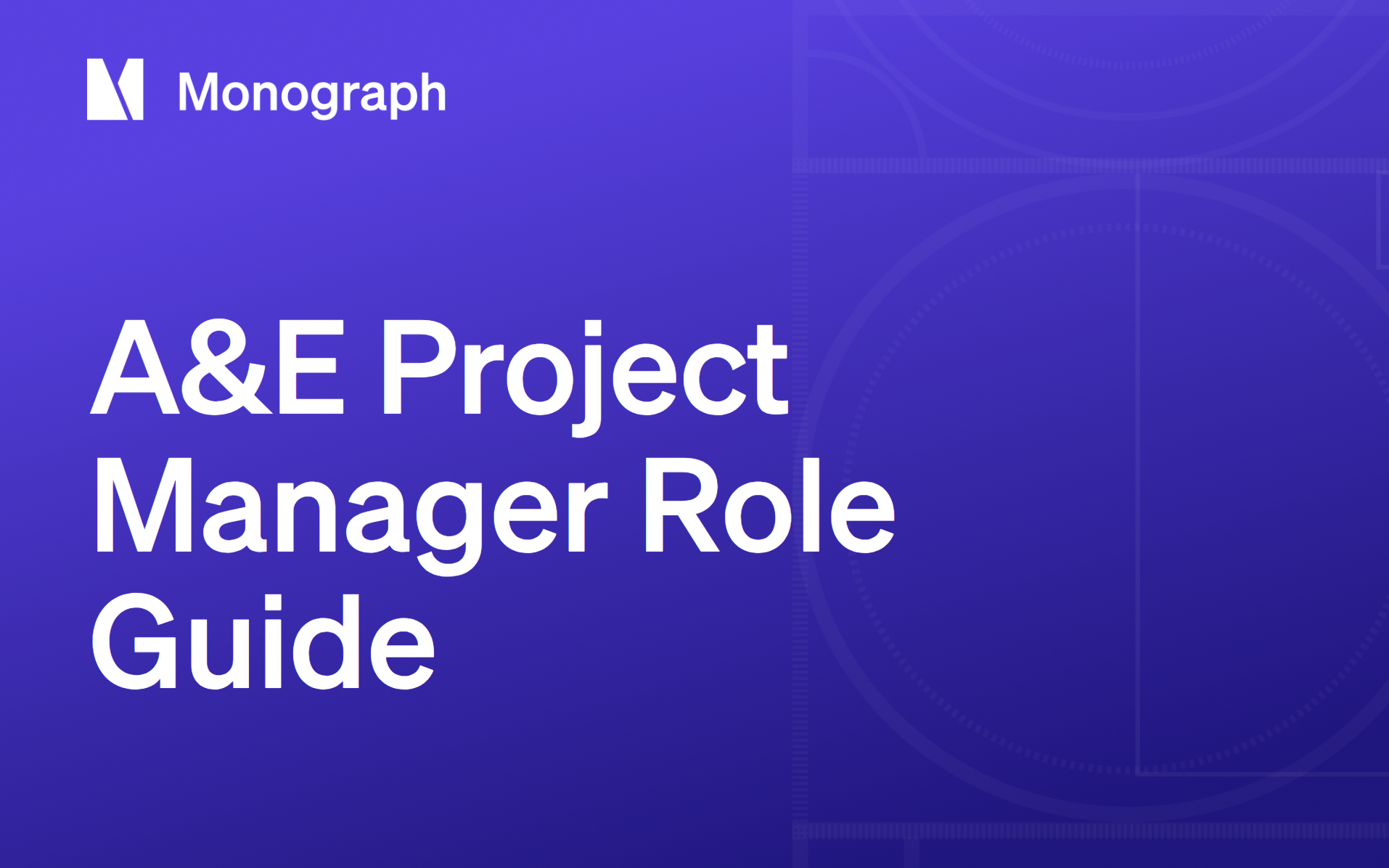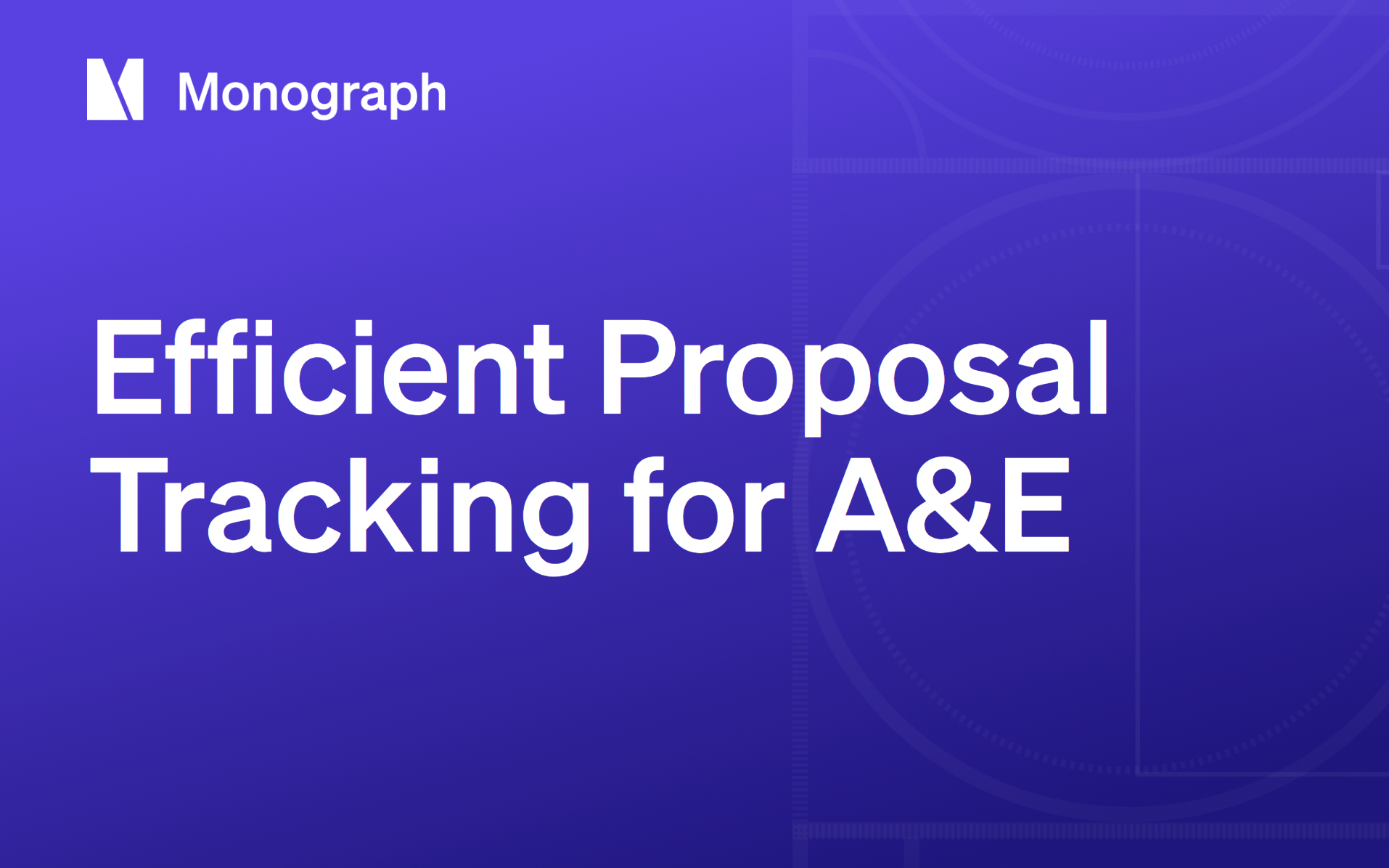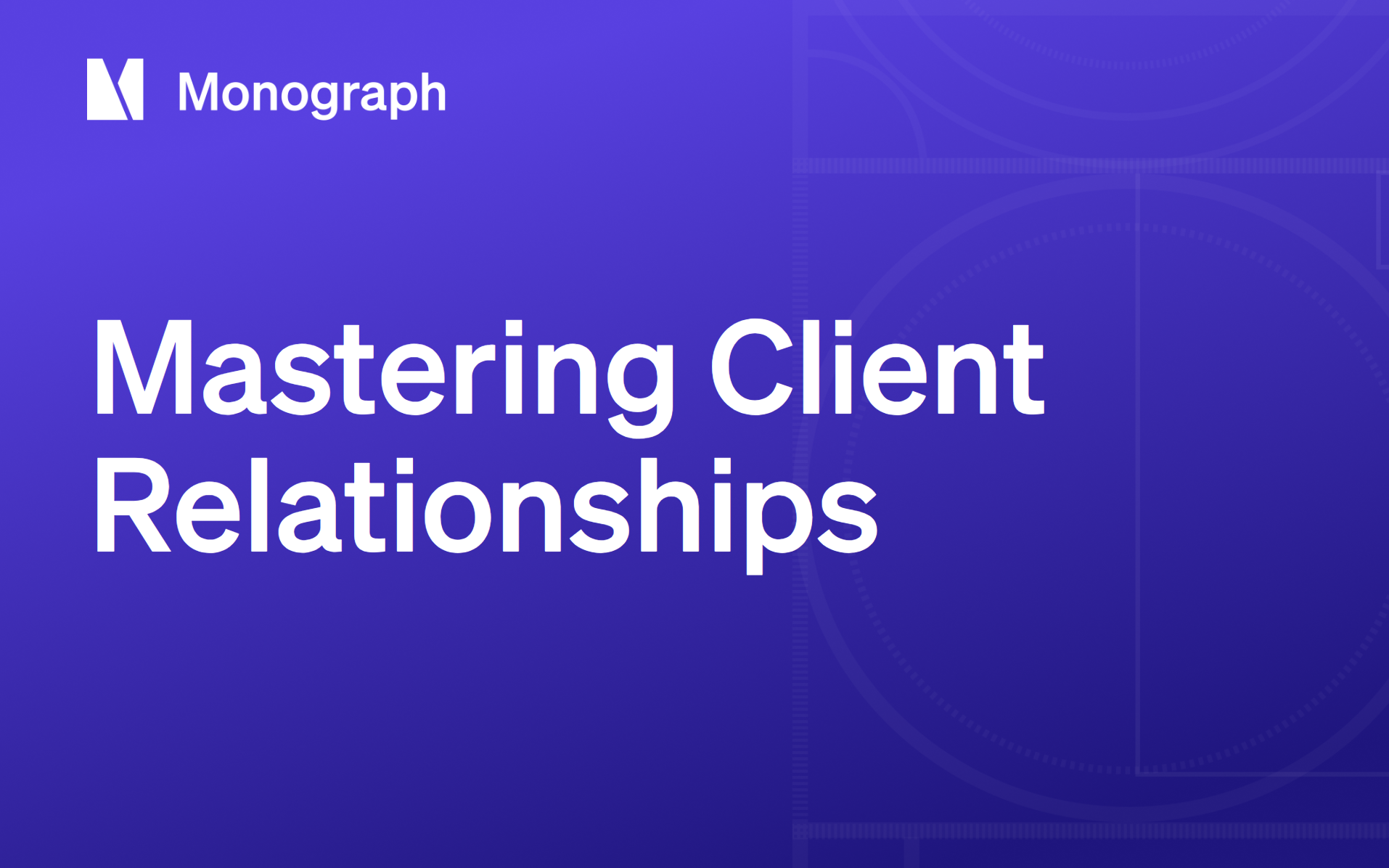Contents
Miss a deadline by a day and the ripple hits your bottom line long before concrete ever hits the site. Effective A&E project management is the structural system that keeps profit, design quality, and team morale standing upright.
Multi-year projects thread through schematic design, construction documents, and field administration. Without a disciplined, phase-based approach like the one outlined in proven frameworks, scope and schedule unravel fast.
This guide delivers a phase-by-phase blueprint, daily routines tested on real projects, and technology solutions from Monograph that replace spreadsheet chaos with real-time visibility.
What Does an A&E Project Manager Do?
You're managing scope, schedule, budget, team, consultants, and client expectations across projects that follow a regulated sequence where mistakes compound exponentially. Fixed-fee contracts make every decision financial. When projects run over budget, those extra hours come straight from your firm's profit, making resource allocation critical to maintaining profitability throughout the project lifecycle.
Consultant coordination is where theory meets reality. Your structural engineer needs soil reports before foundation design, but the geotechnical consultant is waiting for site access approval stuck in permitting. Meanwhile, your MEP partner is asking for architectural floor plans that depend on the structural grid. You orchestrate this network of dependencies while keeping your internal team productive, following established protocols.
Projects pause and restart constantly. Maybe the client needs to secure additional funding, or permits take longer than expected. You shelf a project mid-design and pick it up three months later, but still expected to remember exactly where every discipline left off without blowing the budget on re-familiarization time. PMs that handle this complexity profit consistently and build reputations for reliable delivery.
Phase-by-Phase Responsibilities Blueprint
A&E work follows five phases: Initiating, Planning, Executing, Monitoring & Controlling, and Closing. Your role shifts at each phase, and the handoff between phases is where profit gets won or lost.
Each phase demands different focus areas that directly impact your project's financial health:
- Initiating establishes the contract foundation and stakeholder alignment before any work begins
- Planning translates broad goals into actionable tasks with realistic timelines and resource commitments
- Executing shifts attention to delegation, quality control, and removing obstacles that slow progress
- Monitoring & Controlling provides continuous oversight through metrics that reveal variance before it spreads
- Closing protects reputation through thorough documentation and relationship management for future work
Understanding these distinct responsibilities helps you allocate time and attention where they matter most.
Initiating
Draft a concise project brief, then enter essentials into your management system while they're fresh. Confirm every stakeholder's seat at the table and lock down fee and contract basics so surprises don't surface later. A simple RACI chart clarifies who answers for what; keep it to one page so it actually gets read.
Schedule a kickoff centered on goals, not deliverables, and send a follow-up summary within 24 hours to cement alignment. Monograph trims this setup time. Its AI-aided project creation pulls budget and milestone data straight from the contract, so you start tracking hours and dollars before the first consultant email lands.
Planning
Break scope into a Work Breakdown Structure (WBS) that mirrors your firm's phases, no task longer than two weeks, or you'll lose visibility. Layer timelines and a risk register on top of that WBS; flag high-impact, high-probability items in red so the team can't miss them. If you're looking for a tool to do this, Monograph's planner shows who's overbooked before you promise timelines you can't meet.
Set milestones that matter to clients, 75% Construction Documents (CDs), permit set, Guaranteed Maximum Price (GMP), and publish a communication cadence with weekly owner updates, bi-weekly consultant syncs, and daily internal stand-ups. When everyone knows the beat, fewer details fall through the cracks.
Executing
Clarify deliverables and dependencies, then let specialists work while you clear roadblocks. Regular design QA reviews catch errors early, nothing drives costs up faster than rework discovered in Construction Administration (CA). Keep feedback visual; a marked-up PDF travels faster than a three-page email.
Capture time and expenses the day they happen. We know this, so Monograph's streamlined entry screens make it painless, and approved entries feed invoices automatically, protecting both cash flow and morale. Stay present in consultant channels, quick answers prevent bottlenecks that quietly burn fee.
Monitoring & Controlling
Track Schedule Performance Index (SPI) and Cost Performance Index (CPI) weekly; a CPI below 1.0 is your early-warning siren. Log change requests immediately and route them through formal approval, verbal promises erode profit. Monograph's MoneyGantt™ overlays budget, schedule, and cash projection in one view so you spot variance before it spreads.
Update the risk log, note mitigation actions, and share a concise status report with stakeholders. Transparency here buys trust when you need a change order later.
Closing
Start punch-list walks early so contractors have time to correct defects. For architects, add a sustainability review to confirm material submittals match the spec; engineers should verify as-built drawings reflect field changes. Gather the team for a lessons-learned session while memories are fresh and store it where the next PM can find it.
Archive drawings, Request for Information (RFI), and approvals for legal protection, and push final invoices the same week the client signs substantial completion. Monograph syncs invoices to QuickBooks in real time, so finance can reconcile without extra email threads. Schedule a six-month check-in with the client; ongoing relationships drive the next project long after the last change order is paid.
Daily & Weekly Routines Checklist
When projects move as fast as deadlines, your calendar becomes the backbone of control. It’s worth noting that firms that moved from spreadsheets to real-time dashboards like Monograph's MoneyGantt™ see immediate improvement.
Daily routines require 15–30 minutes each morning:
- Start with a 15-minute stand-up: confirm yesterday's wins, today's priorities, and blockers
- Run a dashboard sweep by scanning Monograph's MoneyGantt™ for budget variance, then check resource allocation
- Handle RFI triage: respond to consultant questions while details are fresh
- Complete communication review: tackle anything that threatens today's milestones
- Maintain time tracking: log hours as they happen
Weekly wrap-ups provide essential project oversight:
- Approve timesheets and expenses to keep billing current
- Generate budget variance and earned-value reports
- Plan next week's staffing
- Review milestones: mark completed deliverables, reschedule what slipped
- Distribute weekly status reports to stakeholders
Following this routine moves you from putting out fires to preventing them.
Core Skills, Certifications & Development Paths
The most valuable project management skills span these core categories:
- Communication excellence translates technical complexity into clear updates that keep all parties aligned
- Financial acumen reads budget dashboards, interprets CPI dips, and explains variance with actionable solutions
- Technical literacy anticipates Building Information Modeling (BIM) coordination conflicts without modeling every detail
- Risk forecasting maintains living registers that catch problems before they mature into claims
- Strategic thinking balances immediate project demands against long-term firm goals
These capabilities work together to create project managers who protect both design intent and profit margins.
You're translating between designers, engineers, contractors, and clients every day, each with their own jargon and priorities. Solid visual and verbal skills let you turn dense mark-ups into two-minute updates that everyone understands. The moment that line of dialogue breaks, risk multiplies, a dynamic KnowledgeHut highlights as a contributor to schedule slippage and budget drift.
Reading a Gantt chart is one thing, but explaining why your CPI dropped below 1.0 and outlining a fix is another. You don't need to model curtain-wall mullions, but you should know enough BIM or REVIT to anticipate coordination choke points. Hiring data shows software keywords are increasingly important, but leadership and project management skills still appear more frequently in most PM job postings.
Professional credentials give skills external validation. PMP certification validates global standards and shows you can run a Work Breakdown Structure in your sleep. CCM signals construction realities beyond the drawing set. LEED credentials demonstrate sustainability expertise shaping today's RFPs. For junior staffers, Google's certificate offers a structured jump-start without the full PMP commitment.
Building expertise requires formal degrees for technical base, but real mastery comes from progressive responsibility, shadowing a senior PM during CA, then taking the reins on a smaller renovation. Career stories highlight education, hands-on exposure, then targeted certifications. Layer in continuous learning, lunch-and-learns on new BIM plugins, short courses on earned value, mentorship circles, to keep your skills as current as your design aesthetic.
KPIs Every A&E PM Should Track
You can't fix what you can't see. The fastest way to lose profit, or a client, is to fly blind on the numbers that tell you how a project is really performing. Once you lock in a handful of KPIs and review them regularly, you gain clarity to act before trouble sets like concrete.
Budget Variance shows how far actual spend has drifted from plan, organizations often set their own thresholds for review. CPI and SPI tell you whether you're ahead of the game, above 1.0, or burning time and money faster than earning it, below 1.0. When these numbers dip, tighten the reins immediately. Your Effective Billing Rate reveals whether billable effort translates into revenue, while Work-in-Progress signals invoices stuck in limbo. A swelling WIP balance means a looming cash crunch that proper tracking exposes in bright red before it becomes a crisis.
Beyond financial performance, operational health indicators reveal whether your firm can sustain current workload:
- Resource Utilization Rate shows if your team is overloaded or coasting, aim for 70-85%
- On-Time Delivery protects your reputation, and missed milestones tank client satisfaction
- Quality metrics like Rework % matter because design errors reaching the job site cost exponentially more
- Invoice Cycle Time bridges operations and finance, shorten it and accelerate cash flow
Track these metrics alongside financial KPIs for a complete picture of project health.
Monograph's MoneyGantt™ surfaces Budget Variance %, CPI, and WIP in one visual sweep, giving you instant intelligence that traditional Gantt charts can't match. Project dashboards plot utilization, delivery, and quality metrics against the goals you set at kickoff. Review high-impact KPIs weekly with your team, monthly with firm leadership, and before every client status call. When a metric flashes yellow, drill down to the task, person, or phase causing the wobble and course-correct before the whole structure leans. That's how data turns into decisions, and decisions into profitable, client-loving projects.
Advanced Strategies: Multidisciplinary Coordination & Risk Management
The best design will stall if risks aren't surfaced early and every discipline isn't marching to the same beat. The process moves through a four-step loop: Identify, Assess, Mitigate, and Review, until the final punch list is closed.
Risk identification starts by walking the site, scanning clash-detection models, and reviewing consultant submittals. A shared risk log inside your project platform means the mechanical engineer, the field superintendent, and you are all flagging issues in the same place, not in three different email threads. The moment a risk is logged, assess its impact, probability, and the cost of doing nothing. A quick impact/probability matrix keeps the conversation objective and fast-moving.
For technical uncertainties, say, an untested façade system, spin up a targeted peer review and assign hours in the resource dashboard. Every Friday, review the log so closed items drop to the archive and open items get new owners or escalations. The ritual takes 15 minutes and saves weeks of rework.
Tell teams that raising a risk earns recognition, not blame. Open meetings by asking, "What could bite us next?" and end closeouts with blameless retrospectives that feed the lessons-learned library. Over time, the message sticks: silence is more expensive than mistakes. Shared visual timelines show architects when structural calculations are due; controlled permissions keep consultants in sync without exposing sensitive financial data.
During schematic design on a mid-rise office, the structural engineer spotted a load-path conflict between a cantilevered terrace and the primary shear wall. Flagging it in week three, not during steel fabrication, avoided a redesign fee and shaved roughly 2% off total construction cost. That single catch paid for the project's entire contingency line. With a disciplined risk loop, a culture that rewards candor, and real-time coordination tools, you turn uncertainty into manageable tasks and keep every discipline pulling in the same direction.
Streamline Your A&E Project Management With Monograph
Throughout this guide, we've explored the critical elements that define successful A&E project management. By mastering daily routines, understanding phase-based responsibilities, and leveraging data-driven technology, you position your firm for profitable projects and sustainable growth.
The role of A&E project managers continues to evolve, but with the right tools and strategies, you can turn insight into impact. Precise budget tracking and seamless project execution become the foundation for transforming challenges into opportunities.
Ready to move beyond spreadsheet chaos? Book a demo with Monograph and discover how real-time project visibility drives profitability.
Frequently Asked Questions
What are the primary responsibilities of an A&E project manager?
A&E project managers orchestrate scope, schedule, budget, team coordination, and consultant management across multi-phase projects. You're balancing design intent with fixed-fee financial realities, managing dependencies between disciplines, and ensuring projects move smoothly from schematic design through construction administration without scope creep or budget overruns.
What skills are most important for A&E project management success?
Communication tops the list, you translate between designers, engineers, contractors, and clients daily. Financial literacy comes next, understanding budget variance, CPI, and earned value keeps projects profitable. Technical fluency in BIM or design software helps anticipate coordination issues, while risk forecasting prevents small problems from becoming major claims.
How do I track project performance effectively?
Focus on Budget Variance %, Cost Performance Index, Schedule Performance Index, and Resource Utilization Rate as your core metrics. Tools like Monograph's MoneyGantt™ give you real-time visibility into these KPIs through visual dashboards instead of buried spreadsheet tabs, letting you spot problems before they compound.
What certifications help advance an A&E project management career?
PMP certification validates your mastery of global project management standards. CCM demonstrates construction administration expertise beyond the drawing set. LEED credentials show you can navigate sustainability requirements in modern RFPs. For those starting out, Google's Project Management Certificate offers a structured foundation without the full PMP commitment.





